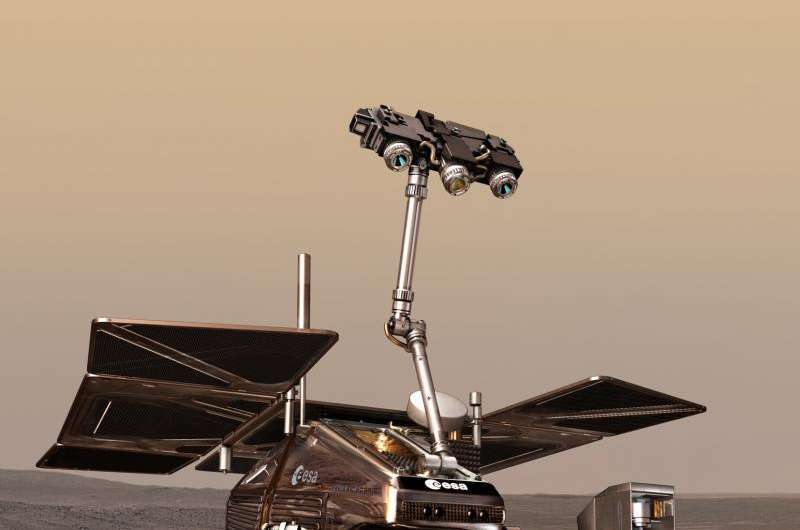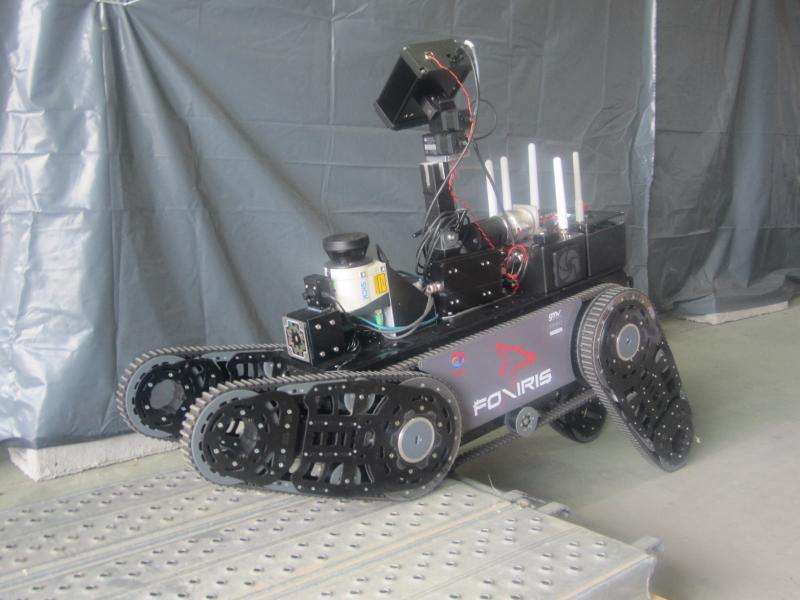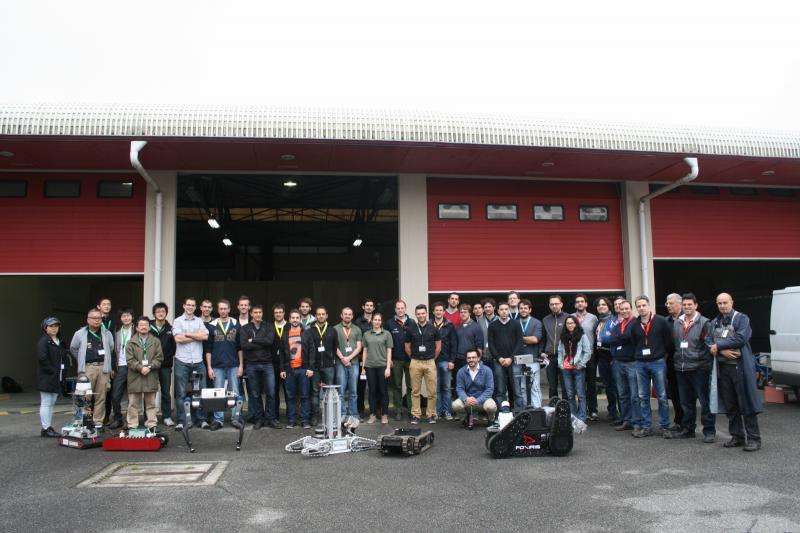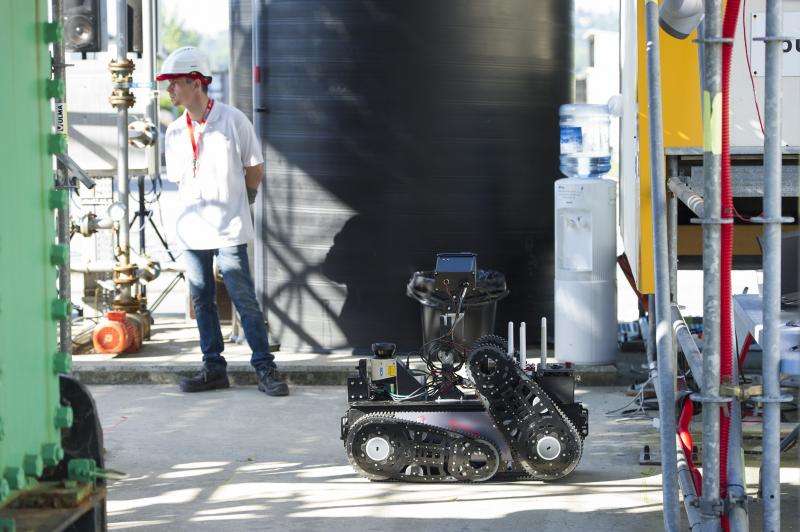The ExoMars rover will be ESA's field biologist on Mars. It will characterise the biological environment in preparation for further robotic missions and then human exploration. Credit: ESA - AOES Medialab
A robot building on ESA's ExoMars rover is bidding to win a place on oil and gas production rigs around the world, to work in remote and hazardous environments.
This robot, developed by a team led by Spain's GMV, is competing in the Total oil and gas company's Autonomous Robot for Gas and Oil Sites (Argos) Challenge. The three-year competition is encouraging the creation of robots to work on hydrocarbon production sites in extreme conditions.
Total envisages that autonomous robots will in future strengthen operators' safety by performing routine, repetitive tasks such as inspections, as well as detecting anomalies, alerting operators and intervening in emergencies.
GMV's Foxiris consortium was one of five teams chosen in 2014 as a competitor.
"We want the robot to be able to move anywhere on a production facility that a human can go today," explained Kris Kydd, Total's Argos project manager from the company's Exploration & Production R&D Department.
"Then, using artificial intelligence, we want the robots to be able to read and record the values on the instrumentation, and to know autonomously whether they are normal or not. If there is an abnormal situation, the robot has to alert the remote operator."
The robots must pass three sets of tests at a plant in Lacq, France, the first of which took place in June. The gas dehydration unit features stairs, narrow walkways and obstacles typical of those found in production plants.
Following the first set of five days' intensive and challenging tests, the Argos jury commented, "Foxiris distinguished itself by its exceptional endurance."
The Foxiris robot is based on a commercially available design from GMV's partner IdMind. GMV is using its knowledge of mobile space platforms to develop the end-to-end control and operation software. The third partner is the robotics academic centre at Universidad Politécnica do Madrid.
Foxiris carries internal navigation sensors and scientific instruments including cameras, thermal imagers, gas sensors and microphones. These allow it to inspect and monitor pressure dials, valves and level gauges, detect hot surfaces, sound alarms and localise gas leaks.
Assisting humans in harsh environments
Argos requires that the robots can operate in extreme climates, including severe cold and heat, heavy rain, high winds and sea spray.
A key requirement for all of the robots in Total’s Argos Challenge is that they have to be able to navigate around the test plant, which includes climbing stairs. Foxiris incorporates flippers at the front and back to allow it to manage stairs and traverse pipes. Credit: Total/V. Li Vigni-Kavanagh
"To enable rovers to work in space we are clearly tackling harsh environments and the oil and gas production market is, by definition, harsh," said Alberto Medina, Head of Robotics Section at GMV.
"Anything which is very harsh and difficult for humans to reach is where we will apply the technologies we have developed initially for space."
"What is important here is human safety. When, for example, you need to check a valve but there are very high winds, then it is much better to send a robot than a human," said Luis Mollinedo, GMV's Foxiris Technical Leader.
"It is also safer to send in a robot where there is a suspected leak of methane or butane."
The robots must comply with European and international safety standards and be able to withstand acidic gases because they will be working in potentially hazardous environments.
From space to terrestrial challenges
Foxiris (Flipper-based Oil & Gas ATEX Intelligent Robotics System) builds on GMV's decades of work in the space industry. The company is working on the Rover Operations Control Centre for ExoMars, which is due to be launched in 2018. It has also developed expertise in remote communications protocols through working on ESA's Meteron.
In addition, the company has worked on the Eurobot Ground Prototype, the Rover Autonomy Testbed, which is being used to study teleoperations, and Goal-Oriented Autonomous Controller, for which it is developing planning and scheduling techniques.
"The technology developed for Mars rovers allows systems to manage themselves in a challenging environment but working on very simple principles," explained Gianfranco Visentin, Head of ESA's Automation and Robotics Section.
"You don't have to give such a rover very detailed instructions. You can simply provide a map of the plant to the rover and tell it what kind of routes it needs to take, how to behave if it finds things which are not supposed to be there, how to cope with uncertainty, and so on."
The Argos Challenge robotics teams gathered for a training session in April 2015. From left to right: AIR-K, LIO, Argonauts, Viking and Foxiris. With the robots together, some of the similarities and differences in their designs become apparent. Most use tracks to move around, although two, including Foxiris, also have flippers and one design has opted to use legs. Credit: VLK Total
It's vital that Foxiris acts autonomously for certain functions, such as deciding whether to raise an alert.
"Such autonomy is vital for our space missions but historically has not been interesting for activities on Earth because why would you waste your time making a robot autonomous when humans nearby can control it?" said Gianfranco.
"Now, though, the approach we have developed has turned out to be interesting for terrestrial applications."
Leading-edge space technologies
"One of the crucial advantages that GMV and their partners have is their extensive experience in advanced space robotics," said Richard Seddon from Tecnalia, the Spanish broker in ESA's Technology Transfer Programme Network, which helps industry in using technologies developed for space programmes to improve terrestrial applications.
GMV’s Foxiris robot overcoming test obstacles at Total’s gas dehydration production plant at Lacq in France during the Argos Challenge in June 2015. Credit: Total/L. Pascal
"They can propose innovations building on technologies and expertise developed to cope with extreme space environments that are also applicable to certain hazardous situations on Earth, such as firefighting, nuclear plants and the oil and gas industry."
For GMV, robotics is the latest of several terrestrial markets to emerge from its space activities for ESA.
"Robotics could seem like old technology," admitted Miguel Ángel Martínez Olagüe, GMV's Chief Business Development and Marketing Officer.
"However, when you talk about autonomous or intelligent robotics – robots that are capable of recognising their situation and making decisions – then it's really in its infancy."
The five teams now have nine months to improve their performance before the second round, due in March 2016, which will be decisive for the final classification.
Provided by European Space Agency



























